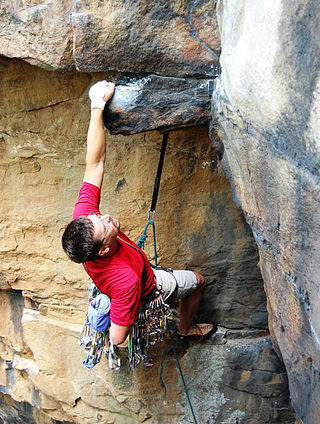
Traditional climbing is a type of free climbing in rock climbing where the lead climber places the protection equipment while ascending the route; when the lead climber has completed the route, the second climber then removes the protection equipment as they climb the route. Traditional climbing differs from sport climbing where the protection equipment is pre-drilled into the rock in the form of bolts.

A climbing route is a path by which a climber reaches the top of a mountain, a rock face or an ice-covered obstacle. The details of a climbing route are recorded in a climbing guidebook and/or in an online climbing-route database. Details recorded will include elements such as the type of climbing route, the difficulty grade of the route–and beta on its crux(es)–and any risk or commitment grade, the length and number of pitches of the route, and the climbing equipment that is needed to complete the route.

In mountaineering and climbing, a first ascent, is the first successful documented climb to the top of a mountain or the top of a particular climbing route. Early 20th-century mountaineers and climbers focused on reaching the tops of iconic mountains and climbing routes by whatever means possible, often using considerable amounts of aid climbing, and/or with large expedition style support teams that laid "siege" to the climb.

Sport climbing is a type of free climbing in rock climbing where the lead climber clips into pre-drilled permanent bolts for their protection while ascending a route. Sport climbing differs from the riskier traditional climbing where the lead climber has to insert temporary protection equipment while ascending.

Rock climbing is a climbing sports discipline that involves ascending routes consisting of natural rock in an outdoor environment, or on artificial resin climbing walls in a mostly indoor environment. Routes are chronicled in guidebooks, and on online databases, with the details of how to climb the route, and who made the first ascent and the coveted first free ascent. Climbers will try to ascend a route onsight, however, a climber can spend years projecting a route before they make a redpoint ascent.
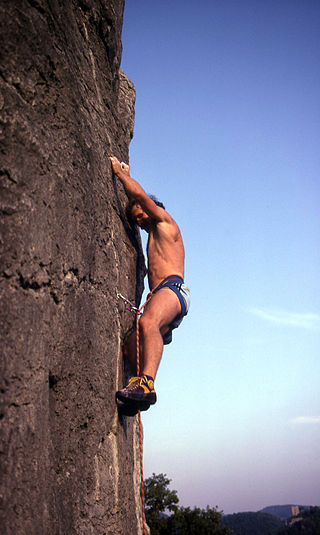
In rock climbing, a redpoint is the free-climb of a route by lead climbing where the climber never used the rope, or any other artificial aids such as their climbing protection, to hold any of their weight during the climb. The climber is allowed to have practiced the route many times beforehand — such as by headpointing or by top roping — and/or to have failed on numerous previous attempts.
Steve McClure is a British rock climber and climbing author, who is widely regarded as Britain's leading and most important sport climber for a period that extends for over two decades, starting from the late 1990s. In 2017, he created Rainman, Britain's first-ever 9b (5.15b) sport route, and by that stage was responsible for developing the majority of routes graded 9a (5.14d) and above in Britain. Although mainly known for sport climbing, McClure has also been one of the most successful British traditional climbers, and British onsight climbers.
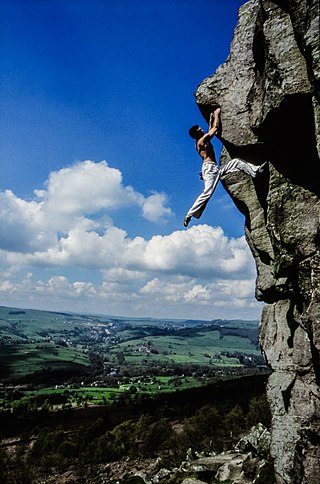
Jerry Moffatt, is a British rock climber and climbing author who is widely considered as being the best British rock climber from the early-1980s to the early-1990s, and was arguably the best rock climber in the world in the mid-1980s, and an important climber in the history of the sport.

In the history of rock climbing, the three main sub-disciplines – bouldering, single-pitch climbing, and big wall climbing – can trace their origins to late 19th-century Europe. Bouldering started in Fontainebleau, and was advanced by Pierre Allain in the 1930s, and John Gill in the 1950s. Big wall climbing started in the Dolomites, and was spread across the Alps in the 1930s by climbers such as Emilio Comici and Riccardo Cassin, and in the 1950s by Walter Bonatti, before reaching Yosemite where it was led in the 1950s to 1970s by climbers such as Royal Robbins. Single-pitch climbing started pre-1900 in both the Lake District and in Saxony, and by the late-1970s had spread widely with climbers such as Ron Fawcett (Britain), Bernd Arnold (Germany), Patrick Berhault (France), Ron Kauk and John Bachar (USA).
Sonnie Trotter is a Canadian professional climber, known for his strength in many rock climbing disciplines – particularly traditional climbing – and contributing to hundreds of first free ascents around the world.

Prinzip Hoffnung, is a 40-metre (130 ft) long traditional climbing route on a thin crack up a conglomerate rock slab on the "Bürs plate cliff" overlooking the village of Bürs in Vorarlberg, Austria. The route was greenpointed by Austrian climber Beat Kammerlander in 2009, and was one of the earliest traditional climbing routes to be graded at 5.14 R (American), 8b/+ (French), X/X+ (UIAA), or E9-E10 (British); it is still considered one of the hardest traditional climbing routes in the world.

In rock climbing, a crack climb is a type of climbing route that follows a system of crack(s) or fissure(s) that the climber uses to ascend the route. The width of the crack dictates the techniques needed, and crack-climbs are further differentiated by the body parts that can be 'jammed' into them, such as finger cracks, hand/fist cracks, arm cracks, and body cracks. Off-width cracks are some of the most awkward, being too wide for the hands or arms, but too narrow to accommodate the body. The rarer top-to-bottom uniform-width crack is called a splitter crack.

In rock climbing a face climb is a type of climbing route where the rock face is fully vertical, unlike in slab climbing, and is largely featureless, unlike in crack climbing. Face-climbing routes are typically sustained and exposed, and longer multi-pitch face-routes can become big wall climbing. Face-climbing became more common with the introduction of sport climbing in the 1980s, when French climbers began to fix permanent bolts into the rock as climbing protection — in contrast to traditional climbing — allowing them to ascend the blanker rock faces in places like the Verdon Gorge and Buoux in France.
Matt Segal is an American professional climber. He participates in a variety of climbing activities including single-pitch traditional climbing and bouldering.
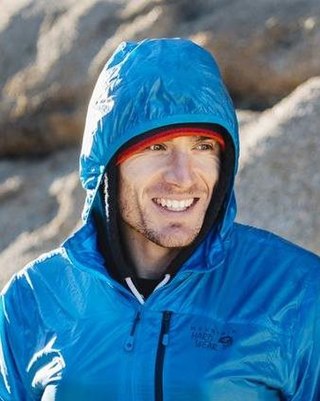
Ethan Pringle is an American rock climber with notable ascents in sport climbing, in traditional climbing, and in bouldering. He has also been active in competition climbing, winning the American national competition lead climbing championships in both youth and adult formats, and silver at the World Youth Championships.
Hazel Findlay is a British traditional climber, sport climber and big wall climber. She was the first female British climber to climb a route graded E9, and a route graded 8c (5.14b). She did the third ascent of the Yosemite traditional route Magic Line 5.14c (8c+). She has free climbed El Capitán four times on four different routes and made many first female ascents on other routes. Climbing magazine gave her their Golden Piton Award (Alpine) for traditional climbing in 2013.
Pete Whittaker is a British professional rock climber. He is one half of the duo known as the Wide Boyz, along with his climbing partner Tom Randall. Whittaker came to notability from crack climbing, including the first ascent of the world's hardest off-width climb, the Century Crack.
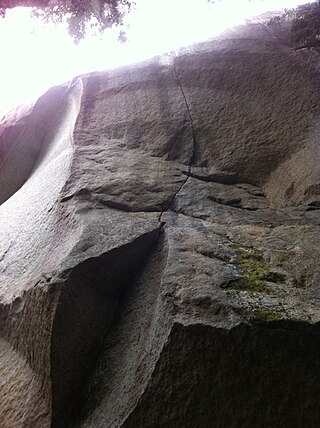
Cobra Crack is a 45-metre (148-foot) long traditional climbing route on a thin crack up an overhanging granite rock face on Stawamus Chief, in Squamish, British Columbia. The route was first ascended by Peter Croft and Tami Knight in 1981 as an aid climb. After it rebuffed many leading climbers, most notably Swiss climber Didier Berthod in 2005, the Canadian climber Sonnie Trotter made the first free ascent in 2006. With subsequent ascents, the consensus grade has settled at 5.14b (8c), which ranked the route as one of the hardest crack climbs in the world, and almost two decades later, it is still considered one of the world's hardest traditional climbing routes.

Barbara Zangerl is an Austrian rock climber who is widely considered as one of the best all-round female climbers in the world. At various stages in her career, she has climbed at, or just below, the highest climbing grades achieved by a female in every major rock climbing discipline, including bouldering, traditional climbing, sport climbing, multi-pitch climbing and big wall climbing.
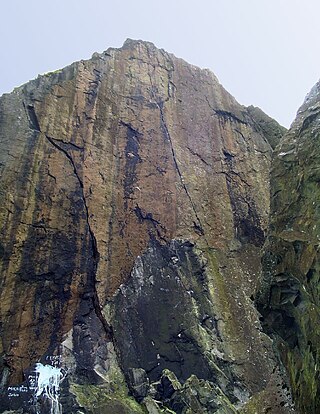
Rhapsody is a 35-metre (115 ft) long traditional climbing route up a thin crack on a slightly overhanging vertical basalt rock face on Dumbarton Rock, in Scotland. When Scottish climber Dave MacLeod made the first free ascent in 2006, it became Britain's first-ever E11-graded route, and at the grade of 5.14c (8c+), Rhapsody was the world's hardest traditional route. It set a grade milestone in traditional climbing that stood for over a decade until the ascent of Tribe at grade E11-12 5.14d (9a) in 2019 and of Bon Voyage at grade E12 5.14d (9a) in 2024.
















